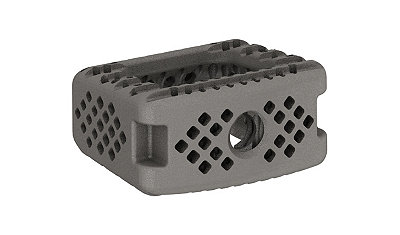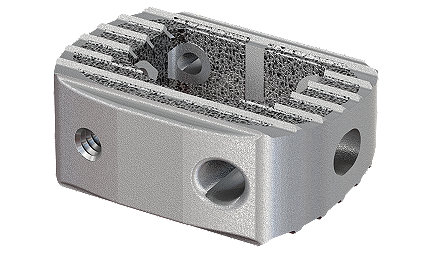Cascadia Cervical 3D
Interbody System
The Cascadia Cervical 3D Interbody System includes a full range of implant sizes carefully designed to accommodate the vertebral anatomy. This system is used in conjunction with instrumentation that allows for implant insertion and endplate preparation.

Main Features
- Roughened titanium surfaces have been shown to demonstrate increased protein expression in contrast to smooth titanium surfaces [1,2,3]
- Implant designed to allow sagittal lordosis
- 0°, 7°, 12° lordotic sagittal profiles
- Reverse hourglass design allows for a large graft volume
- Bulleted nose to ease insertion
References:
1. Karande TS, Kaufmann JM, and Agrawal CM. “Chapter 3: Functions and Requirements of Synthetic Scaffolds in Tissue Engineering.” Nanotechnology and RegenerativeEngineering: The Scaffold, Second Edition. Ed. CT Laurencin and LS Nair. Boca Raton: CRC Press, 2014. Pages 63-102.
2. Bobyn JD, Pilliar RM, Cameron HU, and Weatherly GC. “The optimum pore size for the fixation of porous-surfaced metal implants by the ingrowth of bone.” ClinicalOrthopaedics and Related Research 150 (1980): 263-270.
3. Karageorgiou V and Kaplan D. “Porosity of 3D biomaterials scaffolds and osteogenesis.” Biomaterials 26 (2005): 5474-5491.
Related products
Tritanium C
A hollow implant that consists of configurations of both solid and porous structures built using AMagine Technology, our proprietary approach to implant creation using additive manufacturing. This cage is available in a variety of footprints, heights and lordotic angles to accommodate various patient anatomies. A threaded inserter connection is designed to promote rigid connectivity and control during insertion.
Learn moreThis document is intended solely for the use of healthcare professionals. The products depicted are in accordance with applicable Regulations and Directives.
Please find our full product disclaimer here.
PRTTL-WB-36_31045

